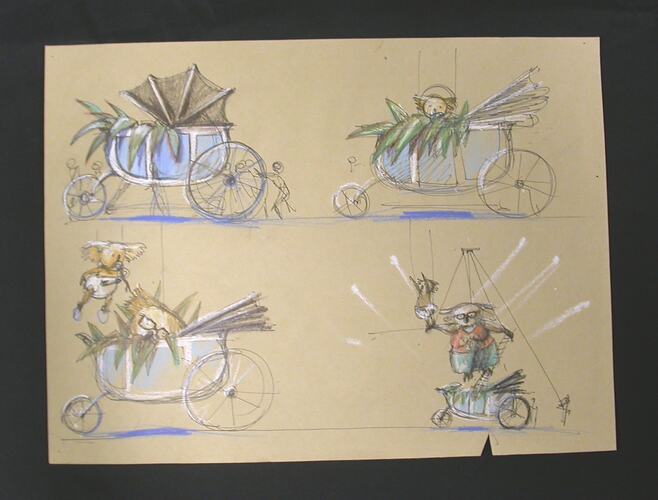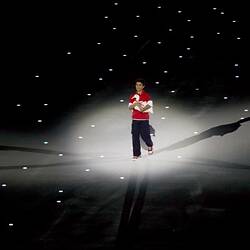In the Opening Ceremony of the Melbourne 2006 Commonwealth Games, the overarching story was about a young boy's journey. This story was told through three main "creative segments." In addition to these, there were two other creative segments, the 'Welcome' and 'Finale', as well as the formal components of the ceremony, the arrival of the Official Party and Her Majesty Queen Elizabeth II, the Athletes' Parade, and the arrival of the Queen's Baton. This narrative outlines the sequence of events in the Ceremony, drawing attention to the story of the performance and its symbolism.
The ceremony began at sunset on March 15, 2006 with the segment called "Welcome to Melbourne". It began with a video that showed the Earth from space, zooming in right to the Melways map 2G, which shows Jolimont, the suburb where the MCG is located. The centrepiece of this segment was the Flying Tram, which swooped down from the roof of the stadium to land in the centre of the circular stage build in the centre of the MCG stadium. Performers, known as the "Citizens of Melbourne" appeared to then exit the tram and move around the stage, dancing and acting together as directed by Nigel Triffit. By starting the ceremony with the transport and people typical of Melbourne in the present, the creators announced their intention that the story was about their hopes for the future of the city, and Australia as a whole, rather looking to the past. This decision was influenced by the fact that the Opening Ceremony of the Sydney Olympics, held just six years before the Melbourne Commonwealth Games, had used historical themes. However, there was also a desire on the part of the creative team to differentiate and tell a different kind of story in this Ceremony, one that looked to the future rather than the past.
Once the action on the stage had come to an end, the Official Party arrived, including the Premier of Victoria, John Bracks, the Prime Minister of Australia, John Howard, and Her Majesty Queen Elizabeth. New Zealand-born soprano Dame Kiri Te Kanawa appeared on stage to lead the stadium in singing 'Happy Birthday' to Her Majesty, who turned 80 in April 2006, ending with a brief version of the anthem of the United Kingdom, 'God Save the Queen.'
Following the arrival of the Official Party, the main story of the ceremony, the Boy's journey, began. According to the Director of the Ceremony, Andrew Walsh, the inspiration for the story and its symbolism came from a poem by Victorian cartoonist and writer Michael Leunig. His "Duck Poem" describes the way the author thinks of Ducks as symbols for a chance to rediscover "wisdom, joy and innocence", as a remedy for the looming seriousness of the adult world, where ".at the peak / Of your great powers," achievements loom "Like a smoking chimney stack." The poem set the tone for the story that unfolded through the rest of the Creative segments, touching on the ideas of wonder and the unexpected as sources of joy and completeness.
In "The Boy on the Bay", the first of the creative segments, a boy walked down the bridge from the edge of the MCG to the central stage, pulling behind him a toy duck as a recording of Leunig reading his poem was played. The image that the Ceremonies team seized upon came from the lines "With a bit of luck / A duck / Will come into your life.She will take you by the hand." and that is exactly what happened in this segment, directed by Rosemary Meyers. When he reached the end of the bridge, a flock of birds represented by puppets in the shape of giant pairs of wings, caused the toy duck to suddenly spread its wings. The toy disappeared in a puff of smoke, to be replaced by a woman with feathery wings and flaming red hair. 'Stella', as she was known, flew up and took the boy with her, and together they moved through the air above the stage. During this part of the segment, known as 'The Flying Dream', and 'Koala Rescue' which followed, the boy explored the wonders of the world of imagination and creativity, experiencing both the highs and lows that come from pursuing your dreams. The Koala Rescue story showed the Boy stranded on the top of a child's imitation of the Arts Centre's spire, having fallen while flying with Stellar. Despite the efforts of a host of Koala rescuers, he fell from the heights into the hole in the centre of the stage.
At this point all the lights in the stadium went out, before a single spotlight fell on an Indigenous Young Woman poling a glowing, angular 'canoe', down the bridge - bathed in blue light to symbolise the Yarra River - from the stadium to the stage. This was the start of the second creative segment, 'My Skin, My Life'. Directed by Wesley Enoch, this segment told about the boy being welcomed to the country of the Kulin Nations, the indigenous people of the Melbourne region. Director Wesley Enoch said that he wanted to show Indigenous people as modern Australians with a deep cultural heritage, "In some ways it's about reviving traditional practices in a contemporary way, not being museum pieces, but being alive and having something to offer right now." The Young Woman rescued the Boy, and together they watched as massed members of Victoria's Indigenous community danced with giant eel and fish puppets, reminders that March is a time of plenty and celebrations in the local Indigenous calendar, centred on the Yarra River. The MCG itself is built on a site that was traditionally used as a meeting place for Aboriginal people, further underscoring the symbolism of this part of the ceremony.
While the canoe echoed the traditional bark canoes, the most important traditional practice incorporated in the ceremony was the wearing of possum skin cloaks. The culmination of "My Skin My Life" came when elders from many of Victoria's Indigenous language groups opened possum skin clocks they were wearing to reveal decorated panels on the inside. The patterns and pictures on the panels tell about the lives of the people in their communities. In addition to the images on the cloaks themselves, the images were also copied on enormous banners that rose from the stage to tower over the dancers, puppets and elders. At the end of the segment, the boy was given a glowing orb, representing his welcome to country and the gift of Indigenous understanding of the relationship between land and people. In this gift, which marked the boy's return to the mundane world, the Creative Team behind the Ceremony were also expressing their hopes for the reconciliation of Indigenous and non-Indigenous Australians.
As the Boy left the stage with the Young Woman, the lights went out again, heralding a transition to the third segment, Under a Southern Sky. The Boy did not participate in this scene. Instead it featured a dance duet - a pas de deux - between a ballerina from the Australian Ballet, and a Trials Motor-Cross rider. Set to "Under the Milky Way Tonight," by Australian band The Church, this scene was about, "a love across divides," according to director Rosemary Myers, and extended the idea of the boy's journey. Where he had learned about the world, and his relationship to Indigenous knowledge and presence, the relationship between these two represented the Commonwealth Games as a chance for all participants to come together and learn from each other. As the ballerina danced, so the Trials rider copied her movements, as around them supporting dancers, both Trials riders and ballerinas, twirled and jumped around the stage. The end of the segment came with the shift of attention to a group of 'Aerial Ballerinas' suspended above the stage. They used hand-held fireworks to shower down sparks that seemed to light a spiral of lights on the stage.
The spiral was the path for the next stage of the ceremony, the Athletes Parade. The Seventy-One teams walked down the bridge from the stadium to the stage, then down the spiral path and around the playing surface. Each of the teams was led by a young woman dressed in blue, bearing the 'placard' with the team's name. In tribute to Melbourne's famously changeable weather, the placards were made from umbrellas. The parade was the longest part of the ceremony, lasting more than an hour.
Once the Athletes were all in the stadium, the Queen's Baton arrived, after having been carried down the Yarra River by the Captains of the 16 Australian Football League (AFL) teams. This last leg of the Baton's journey was part of what was called the 'River Show', another innovative part of the Ceremony. Each of the 71 participating nations was represented by a marine creature, all metaphorically swimming up the Yarra from the sea towards the MCG. Linking the marine creatures was a flotilla of 36 barges, interlinked by pontoons covered with the flags of the participating nations. This floating 'spine' down the centre of the river was nearly a kilometre long, stretching from the Princes Bridge to the Swan Street Bridge. In addition to the Indigenous significance of the Yarra, which was represented in the Ceremony, it provided the creators with another opportunity to celebrate the coming together of all the nations of the Commonwealth.
The Baton's journey down the 'spine' culminated in legendary footballer Ron Barassi 'walking on water' after he received the baton, crossing a perspex walkway set just below the river's surface. The baton was then carried to the MCG and runner Kathy Freeman brought it into the stadium, to a rapturous response from the crowd. It was then carried around the arena by the Australian athletic heroes Ron Clarke and Marjorie Jackson-Nelson, before being passed to the Governor of Victoria, former 1500 metre world-champion John Landy, who passed the baton to Queen Elizabeth II, bringing the 366-day relay to its end. The Queen then read the message from inside the baton, declaring the games open. The formalities concluded with the raising of the Commonwealth Games flag, and the swearing of the athlete's oath, which was taken by Australian swimmer Adam Pine on behalf of all the Commonwealth Games athletes.
After the athletes had left the stadium, the show was closed with the 'Finale', directed by Nigel Triffit. The centrepiece was singer Delta Goodrem performing from a platform that rose out of the centre of the stage. She sang 'Together We Are One', a song written specially for the Ceremony. Meanwhile 'Pyrobladers', roller-blading performers wearing backpacks loaded with fireworks, skated around the stage. As the song ended, the conclusion of the Ceremony was marked by a huge fireworks display that started in the MCG and expanded to encompass roof tops across the Melbourne CBD.
More Information
-
Keywords
international sports events, Sport, performance art, Melbourne
-
Localities
-
Authors
-
Article types

